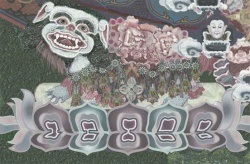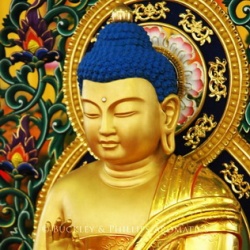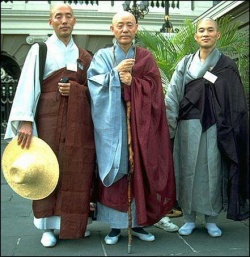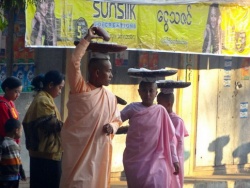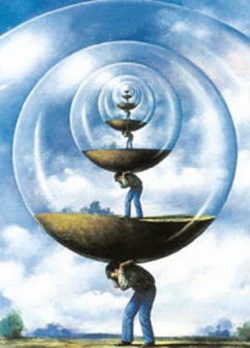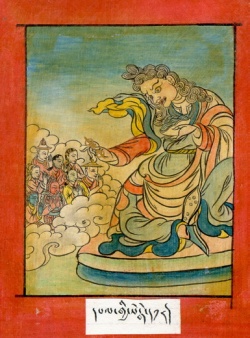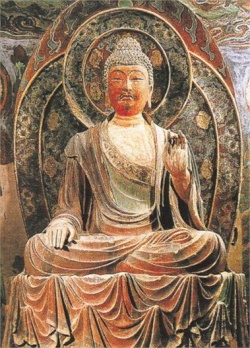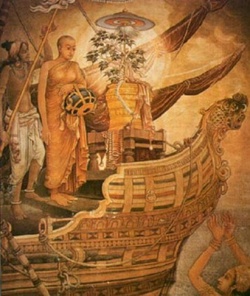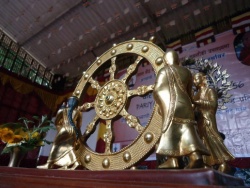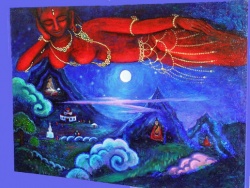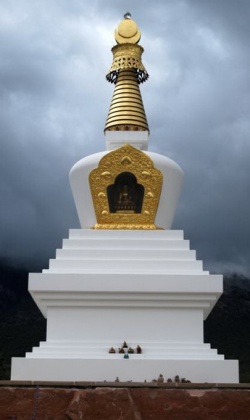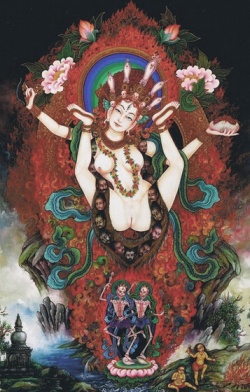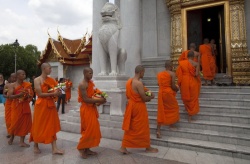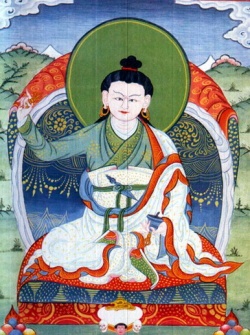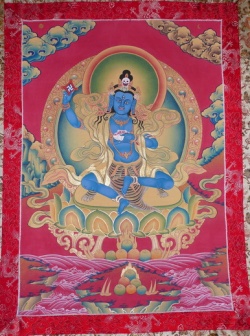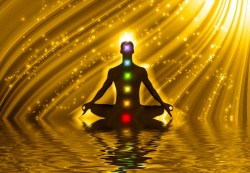Madhyamika Buddhism vis-à-vis Hindu Vedanta (A Paradigm Shift)
Madhyamika Buddhism vis-à-vis Hindu Vedanta
(A Paradigm Shift)
Acharya Mahayogi Sridhar Rana Rinpoche
Famous Indian Hindu scholars like the ex-President of India the late Radhakrishnan state ‘The Buddha did not feel that he was announcing a new religion. He was born, grew up, and died a Hindu. He was restating with a new emphasis the ancient ideals of the Indo-Aryan civilization.’ (2500 Years of Buddhism, 1971, Government of India, foreword, p.ix). Swami Vivekananda said that the Buddha was a great Vedantist for Buddhism was really only an offshoot of Vedanta (The Complete Works of Swami Vivekananda, volume 7, p. 59 and Inspired Talks, volume 3, p. 527). Likewise, Nepalese scholars like Mr. Chudanath Bhattarai, Swami Prapannacharya and scores other Nepalese and Indian scholars, too numerous to be mentioned here, have written that Buddhism is a reaction, a reformation of Hinduism. The Buddha tried to reform some of the malpractice within Hinduism and he never wanted to create a new religion. In short, according to these scholars, Buddhism is correct Hinduism without any malpractice and evils and what is called Hinduism is the malpractice and distorted form of the Vedas.
There are three problems with this interpretation of the Buddha's teaching. One is that if these authors really believe that the Buddha came to reform evils, malpractices and wrong interpretation of the Vedas, then why are they still following these “evils and malpractice” (in their own words) and not practicing the Buddha's teachings, the reformed form of the Vedas? How warped and distorted are the minds of people who, in one breath, proclaim the Buddha as the great reformer of Hinduism and then turn around and call Buddhism (what the Buddha taught) wrong.
Swami Vivekananda contradicts his own statement by stating that he does not agree with the doctrines of the Buddha as the Vedanta is far superior to his doctrines (The Complete Works of Swami Vivekananda, volume 3, p. 572). However, he doesn’t give any reasons or proper refutations to justify how his Vedanta is superior to the Buddha’s doctrines. At least ancient Hindu scholars like Sankaracharya, Ramanujacharya, Madvacharya et al attempted to refute the Buddhist thesis to show how their view was superior, which is fair and the correct thing to do. But these later swamis simply proclaim that their “view” is superior and call it the “Lion’s Roar”. Of course, these authors contradict the Buddha’s own words as found in Pali canons where he has explicitly mentioned that what he taught was new even though it was taught by former Buddhas, but their teachings were completely lost (Pubbesu Ananussutesu Dhammesu, The Dharma Unheard Before, vin. I, 10, v. 420).
The Vedas were certainly not lost at the time of the Buddha as they continue to exist even now. Some of these scholars, including Vivekanada, have gone to the extent of claiming that the Buddha actually only wanted to reform the Vedas, but his disciples misunderstood him and created a new religion. He states that ‘Shankara came, a great philosopher, and showed that the real essence of Buddhism and that of the Vedanta are not very different, but that the disciples did not understand the Master and have degraded themselves, denied the existence of the soul and of God, and have become atheists’ (The Complete Works of Swami Vivekananda: The Sages of India, vol. 3, p. 264).
How illogical it is to believe that the Buddha's own disciples who were validated by the Buddha himself and the unbroken lineages stemming from them did not understand him. Whereas, Hindu swamis and panditas 2,500 years later really understood the Buddha's message! Of course it is not totally the fault of these swamis because during their time facts about Buddhism had vanished from the Indian subcontinent and only hearsay and myths remained based on which these swamis picked whatever they liked. A good example of how mixed up their knowledge of Buddhism was, is evident in the claims made by Swami Vivekanda that what was said in the Kalama Sutta (and that too improvised in a rather confused and mixed up way by him) were the last words of the Buddha (The Complete Works of Swami Vivekananda: Buddhistic India, Volume 3, p. 528). Such totally confused ideas about Buddhism and its history et al are found aplenty in the teachings of Swami Vivekanda and hundreds of such Hindu swamis, panditas and yogis from ancient times to date.
The second problem with the above interpretation made by the Hindu swamis is that it implies that the Buddha was born a Hindu. Simply because Suddhodana was a King and, therefore, called a Ksatriya (warrior class), does not prove that he was a Hindu. First of all, what we call Hinduism did not exist at the time of the Buddha, but rather Vedic Brahmanism existed. Hence, the next question that naturally arises is that if the Buddha was really a follower of the Vedic system, why did he not call himself the great Brahmin or Maha-Brahmin like the great Ksatriya Vishvamitra? It is strange to call the Buddha a proponent of Brahmanism, when he called himself the “Great Sramana” or Maha-Sramana.
Whilst Sramanism is as old as Brahmanism, a lot of research still remains to be done about it. Nonetheless, it can certainly be said that a Sramana is not a Brahmin. Mahavira, the founder of Jainism, also called himself a Sramana. However, if the Buddha was merely reforming the Vedas, why did he not call himself a Neo-Vedic, Neo-Brahmin or true Brahmin, i.e., Maha-Brahmin? Instead, why did he call himself a Maha-Sramana?
I would like to ask those scholars and their followers these questions. Nowhere in the Hindu Shastras (teachings) are Sramanas considered a part of the Vedic tradition. In fact the Smritis (a category of Hindu scriptures) even go so far as to say Brahmins should not take initiations from Sramana systems like Shaivism. It appears that Shaivism was intergrated into the Vedic fold later on. It was customary in India from ancient times to call Kings Ksatriyas (rulers or warriors), regardless of whether they belonged to the Sramana or Brahmana group. Even if Suddhodana belonged to the Brahmin school (of which there is absolutely no proof as yet), and the Buddha may have studied the Brahmanic literatures (The Buddhist scripture the Lalita Vistar implies that he studied Brahmanic literature. Besides other schools, he studied even the Kirata script. The Kiratas who are called Ksatriyas in the Vedic literature were not part of the Indo Aryan fold and thus in no way proves they were Brahmanical). He certainly did not seem to have taken after Brahmanism but rather after Sramanism, which are not the same thing by any historical standards and neither is Sramanism a means to reform Brahmanism.
The third problem is that the teachings found in Buddhism do not in any way appear to be a reformation of Hinduism. Anyone who has studied Buddhism (I am not talking about prejudiced Hindu oriented scholars), can see that there is a major paradigm shift between Hinduism and Buddhism; in fact, between all other religious systems and Buddhism. The post modern and new age concept of universalism regarding spirituality, no matter how romantically beautiful, fails miserably when it comes to addressing Buddhism. A paradigm shift cannot and should not be misconstrued as a reformation. Reforms are changes brought about within the same paradigm. Hence, paradigm shifts are changes in the very foundations or parameters. Therefore, the basic foundations of these practices are completely different.
In such cases, it is completely confused thinking to state that one paradigm is a reformation of another. So Sramanism is a system of religion based on a completely different paradigm than the Vedic-Brahmanism or its offspring Hinduism. Therefore, it would be a gross error to say Buddhism is a reformation of Vedic Hinduism or Vedanta as Swami Vivekanda asserts. First of all, what we call Hinduism today, or even in the time of Swami Vivekanada did not exist at the time of the Buddha, which was the Vedic period. Vedic-Brahmanism was heavily influenced by older Sramanic schools and later on by newer ones like Buddhism and Jainism. We find in the ancient Brihadaranyak Upanishad, Gargi (a female) challenging the Brahmin Yagyavalkya. A critical study of the literature clearly shows that the mode of questioning that Gargi applied was very different from the type that many other Brahmins used to question Yagyavalkya. For instance, all the Brahmins used the same style of questioning in that they were simply asking the correct interpretation of some things found in the Vedas. But Gargi challenged the Vedas and thus she could have been a Sramana, even if she were Brahmin by caste. As Yagyavalkya was not able to answer her questions, he had to stop her by saying ‘Do not ask anymore or else your head will fall off’ (Brihadaranyak Upanishad 3.6.1).
It is these kinds of interaction between Sramanism and Brahmanism that produced the Upanishads and it is the interaction between Buddhism and Vedic Brahmanism (with some influence from Jainism too) that produced what is today called Hinduism. It is in the Upanishadic period that theories identifiable with Shramanas came in direct contact with Brahmanical ideals (Padmanabh S. Jaini (2001), Collected Papers on Buddhist Studies , Motilal Banarsidass Publications, p. 47).
According to Ananda Guruge, a renowned Buddhist leader, the Sramana movement impacted Vedic education through the Upanishads, with debate and discussion replacing parrot-like repetition of the Vedas (Ananda W.P.Guruge (2005), Buddhist Answers to Current Issues, Author House, p. 119). Therefore, it is not a reformation but a shift in paradigm. Even if the Vedic paradigm was older, they are still different from one another. However, whether the Vedic paradigm is really older than the Sramana paradigm is questionable. After all, even though Buddhism began with Shakyamuni, Sramanism is much older. According to the findings of the Indus Valley civilization (3000-2000 B.C.), Sramanism existed in the Indian sub-continent even before Brahmanism entered the region and the Buddha himself has clearly said that there were many Buddhas before him.
It is the purpose of this paper to show how Brahmanism or its offshoot Hinduism and Buddhism are built on two totally different paradigms, even though they share the same language and cultural matrix. It is this sharing of the same language and cultural matrix that has fooled many scholars, especially Hindu biased scholars, who have failed to understand these are two completely different paradigms with very little in common, except the same cultural background, and their language, metaphor, analogy, and words. But as we shall see, the same analogies express two different conceptual structures (paradigms).
I would like to clarify that this is a differentiation between the two paradigms and not a denigration of Hinduism or the Vedanta which are wonderful creations of humanity. It is a refutation of the outdated and baseless notion that Buddhism is a branch of Hinduism or a reformation or based on Hinduism et al and not a denigration of Hinduism. This kind of healthy refutation and rebuttal existed between Buddhism and Hinduism from the time of the Buddha till around the twelfth century when Buddhism collapsed in India after the Islamic invasion. According to the diary of one of the invaders Bakhtiar Kilji (1193 AD), the armed forces specifically targeted the Buddhist monasteries mistaking them to be military centers rather than academics.
Until then it was Buddhism that kept expanding throughout India and Asia. It is said that seventy five per cent of India was Buddhist. Here too, the general Hindu concept put forth by many Hindu scholars like Vivekananda et al that Hinduism took back Buddhism into its fold and that is how Buddhism vanished from India is totally misleading and historically unfounded (The Complete Works of Swami Vivekananda: The Sages of India, volume 3, p. 265). Also, virtually all famous Hindu Vedantic scholars like Madhvacharya (1238-1317) interpreted Buddhism incorrectly. Madhvacharya states that ‘Madhyamiko vivartam akhilam, sunyasya ene jagat.’ That is ‘The Madhyamics believe that all this Samsara is an illusion and the Samsara/jagat comes out of emptiness.’ (Sarva Darshan Sanghraha). Likewise, hundreds of Hindu scholars after him just assumed this was the true interpretation of the Madhyamic. They have used it either to refute the Madhyamic or to validate that the emptiness of the Madhyamic is just a negative way of stating the Brahman out of which the universe comes out. However, the Hindu scholars have not had the opportunity to face real Buddhist refutation of their notions for a long time till now, mainly due to language barriers. As they say, the mice will play when the cat is away.
When we compare the Advaita Vedanta, especially as interpreted by Shankara, and the Madhyamika, whether it is the Svatantric form of Bhavya or Prasangic form of Candrakirti, the sharing of the same language, culture and analogies, (while talking about two different paradigms), become obvious. I have chosen Sankara Vedanta because of all sub paradigms within Hinduism, it is the Sankara Vedanta that appears to come closest to Madhyamica Buddhism. Even Vivekananda seems to think the same with a slight Hinduistic twist as he mentions in his Buddhism and Vedanta that the Vedanta philosophy is the foundation of Buddhism and everything else in India. However, what we call the Advaita philosophy of the modern school has great many conclusions for the Buddhists.
For instance, the Upanishads themselves are a mix of different concepts susceptible to many interpretations as have been made by various famous interpreters such as Ramanuja, Madhava, Vallabha, Bhaskara, Nimbarka and Yamuna. These are obviously so different from Buddhism that they do not warrant a comparison. The Shaivadvaita of KashmirShaivism also is similar to Sankara Vedanta in many ways. Even though there are fine differences, which we cannot go into here, however, they too use similar words to point at different paradigms.
Because the same language structure (be it Pali or Sanskrit) and the same analogies are used to express two different paradigms, many Vedantins or scholars of Buddhism with Vedantic backgrounds have been fooled into thinking Buddhist Madhyamika is a re-interpretation of Hindu Vedanta. For example, many like Vinova Bhave the guru revered by the late Prime minister of India Indira Gandhi, perceive Buddhism as a negative way to attain the same goal (via negativa), whereas Hindu Vedanta is the positive way (via positiva). Likes of Bhave and others argue that the Buddhists use negation, whereas the Vedantis use affirmation and therefore the Shunyata of Buddhism is a negative way of talking about the Brahman of the Vedanta.
The issue here is not via negative or positive, but rather approaching two different goals based on two different paradigms, or addressing two diametrically opposed answers to the burning issue of mankind developed from diametrically opposed paradigms. In fact, the Buddha, after engaging in long years of Brahmanic as well as Sramanic meditations, found the concept of Brahman (an ultimately real, unchanging, eternal substratum [ paramartha satta ] to this ephemeral transient world) inadequate to solve the basic issue of humanity, i.e., suffering (dukkha ). He questioned the very existence of such an eternal substratum and also declared that a search for such an imagined Brahman ( parikalpita atman) was a form of escapism and, therefore, not really spiritual but “Spiritual Materialism”.
Since the concept of Brahman, the truly existent (paramartha satta) is the very foundation of Hinduism (as a matter of fact some form of an eternal ultimate reality whether it is called God or Nature is the basis of all other religious systems). When Buddhism denies such an ultimate reality (paramartha satta) in any form, it cuts at the very jugular veins of Hinduism and all other Theistic systems. Therefore, it cannot be ontologically, epistemologically, and soteriologically said that Buddhism reforms Hinduism.
The affirmation of a ground (asraya) which is really existent (paramartha satta) and the denial that such an existent ground (satta) can be found anywhere, within or without, immanent or transcendent, are two diametrically opposed paradigms, not simply variation or reformations of each other. The Webster Dictionary defines re-form as ‘to amend or improve by change of form or removal of faults or abuse.’ The example I have given above of an eternal base without which Hinduism in its own language would be called atheistic (Nastik). Therefore, the denial (without any implied affirmation prasajya pratisheda) of such an eternally existing unchanging base by Buddhism cannot be said to be a reformation, but a deconstruction of the very roots of the Hindu thesis. That is why Buddhism is not a reformation of Hinduism but a paradigm shift from the foundations on which Hinduism is based.
Hindu scholastic polemics assert that without an ultimate eternal reality (pramartha satta), there can be no liberation from the changing, transient Samsara which is an illusion. Therefore, even though the Buddha denied such an ultimate reality, he could have meant only conceptually really existing reality/relative reality, not the eternal ultimate reality, which is beyond concepts. Otherwise there cannot be liberation. The fault with this kind of thinking is that it is measuring the thesis of the Buddha (which is no thesis), or interpreting the Buddha from within the Hindu paradigm, within which, an eternal ultimate reality (paramartha satta) is a necessity for soteriological purpose, i.e., for liberation as Samsara itself is merely an illusion (maya) and cannot liberate us. However the Buddha saw this as a necessary dead-end. Since according to the Buddha, there is no Brahman, such a concept being merely an acquired fabrication (parikalpana) learned from wrong (mithya ) scriptures, hankering after or searching for such a Brahman leads nowhere, let alone liberation. Hence, the Buddhist paradigm if understood correctly, does not require an eternally existing something or other for liberation.
In Buddhism liberation is not about realizing such a ground but rather letting go of all grounds, i.e., realizing the “groundlessness” of Samsara which is not really an illusion per se but “like an illusion” (mayavat). As Nagarjuna puts it aptly in his Magnum Opus, Mulamadhyamakakarika ‘sarva drishti prahanaya yah saddharmam adeshayet.’ That is ‘the Buddha taught out of compassion the true dharma for the sake of letting go of all views.’ (Drishti Parikshya, Investigation of view, chapter 27 verse 30). In the Theravadin Majjhima Nikaya, Dighanakha Sutta and the Aggivacchagotta Sutta , the Buddha himself says that ‘all others leave one view only to hold on to another view but the Tathagata let goes all view and does not grasp to any other view.’ The Phenopindopama Sutra states very clearly that the five aggregates ( pancha skandha), which is the Samsara, is like a bubble, like foam, like an illusion. It does not say the five aggregates are an illusion but “like an illusion”. In fact, according to Buddhism, holding on to any ground is ignorance and is called innate clinging to the concept of a truly existing self (sahaja atman graha).
Therefore, in the Buddhist paradigm, it is not only ‘not necessary’ to have an eternal ground for liberation, but in fact, the belief in such a ground itself is part of the dynamics of ignorance. We now move to another major difference within the two paradigms.
In Hinduism liberation occurs when this illusory Samsara is completely relinquished and it vanishes; what remains is the eternal Brahman, which is the same as liberation. Since the thesis is that Samsara is merely an illusion, when it vanishes through knowledge (jnana) only an eternally existing self called the Brahman remains and if there were no eternal Brahman remaining, it would call for a disaster. So in the Hindu paradigm (or, according to Buddhism, all paradigms based on ignorance), an eternal unchanging, independent, really existing substratum/ base (Skt: Ashraya, Zhi in Tibetan) or the ‘great substance’ (Mahavastu) is a necessity for liberation, otherwise one would fall into Nihilism. But since the Buddhist paradigm is totally different, the question posed by Hindu scholars: how can there be liberation if a Brahman or the first cause does not remain after the illusory Samsara vanishes into wisdom/enlightenment (jnana/yeshe) is not relevant within the Buddhist paradigm and does not hold any ground in its enlightenment, Bodhi or Nirvana. The fact that all Dharmas are interdependently originated (pratityasamutpanna) implies that there can be no first cause/creator God unless these too can arise interdependently. This is why many Hindu scholars from ancient times considered Buddhism as a nihilistic system (nastika), which actually means non-believer.
First of all, to the Buddha and Nagarjuna, Samsara is not an illusion/maya but like an illusion (mayavat) as the Phenopindopama Sutta found in both Theravadin, Mulasarvastivadin and Mayahayana texts make it clear. To Sankara, the Samsara is an illusion as his famous verse quoted from the Puranas state ‘Brahman satyam jagan mithya’, which means ‘Brahman is the truth meaning really existing (Sat) and the jagat/Samsara is false/illusion.’ According to the rest of the verse, this is the main essence of the thousands of Hindu scriptures described in half a verse: ‘Shlokardhena pravachhyami yaduktam grantha kotibhi’. Also, Sankara repeatedly calls the Samsara illusion (maya) in his commentaries of the Prasthan Trayi (The three pillars of Vedanta –viz- The Brahman Sutra, the eleven or so main Upanishads and the Bhagavat Gita). There is a quantum leap in the meaning of these two statements. If Samsara is merely an illusion, it cannot be the basis for liberation as it does not exist at all in any way whatsoever. How can a barren woman’s son or a vixen’s horn be the basis of our liberation when there is no such thing?
However, if it is interdependently arising and appears like an illusion, it can become the source of our liberation. Secondly, because it is only “like an illusion”, i.e., interdependently arising like all illusions, it does not and cannot vanish. So, Nirvana does not arise when Samsara vanishes like mist and the Brahman arises like a sun out of the mist, but rather when seeing that the true nature of Samsara is itself Nirvana. That is, Samsara transforms into Nirvana as the Hevajra Tantra 2.4.38 clearly states ‘ami dharmas tu Nirvana mohat Samsararupina’, meaning ‘all Dharmas/phenomena (Samsara) are essentially Nirvana but because of delusion they appear as Samsara.’ It further mentions that ‘amudah Samsaran shuddhaya samsaro nirvrittayate’, that is ‘the undeluded one functions in the world purifying the Samsara into Nirvana.’ Whilst Brahman and Samsara are two different entities: one real, the other unreal; one existing (Sat) and the other non- existing (asat). Just like Samsara being superimposed on the Brahman like a snake on a rope, the two can never be one. Hence, Samsara and Nirvana in Mahayana Buddhism are one and not two separate things.
Nirvana is the nature of Samsara or in Nagarjuna's words Shunyata is the nature of Samsara. In the Mulamadhyamaka Karika, chapter twenty five verses 19-20, Nagarjuna writes there is absolutely no difference between Samsara and Nirvana and the same concept is also found in the Hevajra Tantra section two, chapter four, verse 38, as mentioned earlier ‘ami dharmas tu Nirvana mohat Samsara rupina’, that is all these Dharmas (Samsara) are Nirvana but because of delusion (moha) they appear as Samsara. It is the realization of the nature of Samsara as empty which cuts at the very root of ignorance and results in knowledge not of another thing beyond Samsara but of the way Samsara itself actually exists (vastusthiti), knowledge of Tathata (“as it-is-ness”) the Yathabhuta (“as it-really-is”) of Samsara itself. It is this knowledge that liberates from the wrong conceptual and conditioned experience of Samsara to the unconditioned “experience” of Samsara just as it is. That is what is meant by the indivisibility of Samsara and Nirvana (Skt.: Samsara Nirvana Abhinnata, Tib.: Khor De Yer Me).
Nirvana being the Mind (Tathagatagarbha), in the context of Mahasandhi/Dzogchen, Mahamudra/Chyagchen and Anuttara Tantra, Samsara could be substituted by the dualistic mind. The Hevajra Tantra 2.4.77 states ‘chittam eva hi sambuddho, na buddho’nyatra darshita’ meaning ‘mind itself is perfectly enlightened and nowhere else is the enlightened one to be perceived.’ Krisnacharya comments in his Yogaratnamala Commentary, ‘chittam evahi bodhichittam’ meaning the ‘Chitta means the Bodhichitta (Enlightened Mind).’ Ratnakarashanti also comments on the verse in his commentary called the Muktavali, stating ‘chittameva bodhih satvanam tatha pragapi tesham tesham chittasamataya’ meaning ‘by mind itself is meant the mind of enlightened beings and also before enlightenment because the mind is the same/similar. The Hindu paradigm is world denying, affirming the Brahman .The Brihadaryanaka Upanishad 2.4.12 says ‘na pretyasangyastityare’ that is ‘there is no more consciousness of the particular’ and Sankaracharya in his commentary of this verse further states ‘…. how can the knower of Brahman who is established in his nature as pure awareness (vigyanaghana) possibly have any such particular consciousness…..even when the man is in the body, particular consciousness (Samsara) is impossible at times, as in deep sleep, so how can it ever exist in a man who has been absolutely freed from the body and organ (Samsara).’
The commentaries on Yogavasitha mentions that a realized yogi loses all consciousness of the external world and is immersed in the Brahman so much so that the yogi is incapable of looking after him/herself and has to be fed by other people. According to the Hindu Avadhuta system, an avadhuta is someone who has lost all contact with this world and lives in the inner world could be called an eccentric who does not care anymore for social norms. Whereas, the Buddhist meaning of Avadhuta is closely related to kusulipa or chodpa, which means a person who practices offering him/herself including the body (the most cherished aspect of a person) to all sentient beings through special meditational practices called chod/chedan or Kusuli Yoga.
The Mahayana Buddhist paradigm does not deny the world; it only rectifies our wrong vision (mithya dristi) of the world. Therefore, of what use would a Bodhisattva who has lost all contact with this Samsara be to anybody? And how could any Bodhicharya/Bodhisattva activity be conducted in such a state? In fact, discriminating knowledge (pratyavekshyana gyana) of the particular (pratya) is part of the Bodhisatva’s enlightenment. The Buddha never lost contact with the “here and now” (Samsara) except when he was in samadhis. The Mahayana does not give importance to a dream beyond or a separate transcendence from Samsara. According to Buddhism, such a dream is part of the dynamics of ignorance and to present such a dream would be to perpetuate ignorance. In Buddhism, any system or paradigm which propagates such an unproven and not provable dream as an eternal substance or ultimate reality, be it Hinduism or any other “ism”, is propagating spiritual materialism and not true spirituality. In contrast, in Hinduism such a Brahman is the Summum Bonum of its search goal, the peak of the Hindu thesis. The Hindu paradigm would collapse without it. Since Buddhism denies this, it cannot be honestly said that the Buddha merely meant to reform Hinduism. As I have repeatedly said, it is a totally different paradigm. Hinduism, Christianity, Islam, Jainism are all variations of the same paradigm, although Jainism is non theistic like Buddhism it is also based on the Atman-Brahman concept or an ultimately truly existing self/reality. So truly speaking, you could speak of them as reformations of each other. But Buddhism has a totally different paradigm from any of these, not merely from Vedic- Hinduism. This leads us naturally to the concept of the two truths (satya dvaya).
Both Hindu Vedanta and Madhyamika Buddhism (and for that matter all forms of Buddhism), use the above concept to clarify its paradigm. But again the same words point at two different paradigms. First of all, the concept of the two truths clearly stated in Buddhism, that the Buddha himself used, penetrated Hinduism only after Shankaracharya (seventh/eight century) Even though Patanjali's had appropriated a lot of Buddhist concepts and words in his Patanjala Sutra, he did not speak about the two truths per se. According to Surendra Nath Dasgupta the first three main chapters of the Patanjala Sutra which deals mainly with meditation, is just a Hinduized rehashing of Buddhist meditational concepts and the last chapter where Buddhism is criticized is the work of somebody else who wrote it later as the style is different (A History of Indian Philosophy, vol 1.7.pp.229-30).
However, even though Sankara copied these words from Buddhism and also copied many other conceptual words from Nagarjuna to elucidate his Vedantic paradigm (that is why he was accused of being a crypto-Buddhist [Prachhanna Bauddha) by Bhaskaracharya), the meaning of the paradigm that he tried to clarify using the same words is different. So he was never really a crypto Buddhist but rather a virulent critique of Buddhism. In his Sariraka Bhasya ( Brahman Sutra 2.2.32) he has called the Buddha ‘an incoherent babbler who showed his malevolence towards all creatures acting under delusion…giving contradictory views.’ So much for those western disciples and some western Buddhists who claim that the Sankara Vedanta/Hinduism and the Madhyamic/Buddhism are essentially the same!
In many places these conceptual wordings and analogies are forced to produce the meaning that is required for the Vedantic paradigm. In the Vedantic context, the relative truth (Vyavahar Satya or Samvritti Satya in Buddhism) is that this Samsara is an illusion and the ultimate truth ( paramartha satya) is that there is an ultimately existing thing (paramartha satta) transcending/immanent in this world. Therefore, the relative truth will vanish like an illusion and both the transcendent and immanent Brahman (the ultimate truth/paramartha satta) will appear as the only truth, hence the world/Samsara being false: ‘Brahman satyam jaggan mithya’ that is ‘Brahman is really existing and the Samsara is an illusion.’
To sum it up, the Vedantic ultimate truth is the existence of an ultimate existence or ultimate reality called Atman-Brahman. Reality here is used as something which exists (satta/sat). Sri Sankaracharya defines Sat or real existence in his Tatva Bodha as that which remains the same and unchanged in all the three times (kala trya api tishtatiti). The three times means the past, present and the future. Thus the ultimate reality has to remain unchanged and that reality is the ultimate truth.
However, the Buddhist ultimate truth is the absence of any such satta, i.e., and ultimately existing thing or ultimate reality. The significance of Shunyata is the absence of any real, independent, unchanging existence (svabhava) and that fact is the ultimate truth of Buddhism, which is diametrically opposite of the ultimate truth of the Hindu Atman-Brahman. So Shunyata or emptiness can never be via negativa, a negative way of describing the Atman-Brahman of Hinduism as Vinoba Bhave and such scholars would have us believe. The meaning of Shunyata found in Sutra, Tantra, Dzogchen and Mahamudra is the same and officially accepted by all four schools of Tibetan Buddhism (except those who adhere to the Shentong view) and that is the Prasangic emptiness of Chandrakirti, i.e., the unfindability of any true existence or simply unfindability (unupalabdhi).
Some writers of Dzogchen and Mahamudra or Tantra think that the emptiness of Nagarjuna is different from the emptiness found in these systems, but such an idea contradicts the view presented by Acharya Tripitaka Kamala in his Vinaya Pramod and Advaya Vajra in his Advaya Vajra Sanghraha. Both authors state (an oft quoted verse in Tibetan texts too) that ‘Ekartha tve apya asammohad buhu upaya duskarad,’ meaning ‘even though the view/goal of Tantra and Sutra are the same Tantra is special in having many skillful means.’ Since the goal of sutra is the non dual realization of emptiness which is not different from luminosity (as per the Pragyamaramita Sutras) and the emptiness of Sutra is as elucidated by Nagarjuna and his sons, the emptiness of Tantra and Dzogchen has to be the same emptiness.
Therefore, to claim that the Emptiness of the Dzogchen and Tantra are different from the emptiness found in the Sutra is false. The Hevajra Tantra 2.5.67 itself states very clear that ‘this is that great bliss where there is neither ‘no-self’ (anatman/sunyata) nor other’ ( ehu so paramamahasuha nau para nau appana). So it is not only empty of others but also of the self (svabhava). However, I would like to ask them whether their emptiness is findable or unfindable? Whether the significance of emptiness in these systems point towards the ‘unfindability’ that is free from the four extremes (tetralemma) or ‘no seeing’ as it could also be expressed? Also some Shentong scholars (by Shentongpas I mean the Dolpopa Shentongpas specifically, who seem to have abandoned the Prasangic emptiness and not those who have not abandoned the emptiness, like the Minling, Terchen and Shakya Chogden) seem to imply that the Shentong system is talking about a different emptiness. They say that the Buddha nature is not empty of qualities therefore, Buddha nature is not merely empty, it also has qualities.
First of all the whole statement is irrelevant as the issue is not about qualities or the Buddha nature being empty of quality or not. The Buddha nature is empty of “real existence” (svabhava). Because it is empty of real existence and because it is nishwabhava or “non-real-existent” (another name for emptiness), it has qualities. As Arya Nagarjuna has said in the Mulamadhyamikakarika ‘all things are possible (including qualities) because they are empty.’ The Samadhiraj sutra says ‘know all things to be like this: a mirage, a cloud castle, a dream, an apparition, without essence (meaning empty) but with qualities that can be seen.’ The Theravadin Majjhima Nikaya 1.297 and Samyutta Nikaya IV 296-97 further state ‘sunnam idam attena va attaniyena va’, meaning ‘this Samsara is empty of self or anything pertaining to self.’ Therefore, the mind is an integral part of what Buddhism calls Samsara/world and this mind is Buddha (Tathagatagarbha), which is also empty in the same way and not in some other way.
If the Buddha nature (Tathagatagarbha/Sugatagarbha) was really existing (sat) and not empty (nishwabhava), in the Sutra sense, like the Brahman of the Hindus, then the same fault that ancient Buddhist masters blamed on the Hindu Atman-Brahman would boomerang on these Buddhists too. An unchanging really existing thing cannot function in any way as function implies change (Tatva Sanghraha, chapter 7, section E, text 332-335 of Shantarakshita commentary by Kamalashila). Therefore, how can such a Tathagatagarbha that is unchanging have any qualities as it cannot function in any way. If it is answered that the function of the Buddha’s qualities are inconceivable (acintya/sam gyi mikhyab), a further question arises that is, how can a conceivable Tathagatagarbha (as to say it exists is to bring it down to the level of conception and thus conceivable) have inconceivable qualities? For the Tathagarbha to have inconceivable qualities, it would also have to be inconceivable. We now come to the point of Nagarjuna that the Tathagarbha must also be free from the four extremes (tetralemma) which means empty of real existence. Therefore the whole Shentong/Rangtong issue is superfluous. And if the Tathagarbha becomes really existing then Buddhism loses its main thesis that differentiated it from Hinduism from its very inception.
We find even Hindu scholars as early as 300 AD like Vatsayana through Bharahar Sutra (Sutta) trying to prove that the Buddha actually taught the Atman but the Buddhists did not understand. This statement implies that there were no Buddhists who understood the Buddha. It further implies that until the time of Vatsayana, Buddhists did not agree with the Atman theory. However, in most kinds of Shentong (except the Dolpopa Shentong), Buddha nature is also empty and emptiness means unfindable that is free from the four extremes as per Nagarjuna-Chandrakirti.
In the tradition of the Mahasiddha Lord of Yogins (Yogeshwar) Virupad, who is one of the famous eighty four Mahasiddhas as well as a great scholar and an abbot (Upadhyaya/Khenpo) of Vikramashila; luminosity (prabhashwar), clarity or pure awareness is the store house consciousness (alaya vigyana) which is the relative truth and the Tathagarbha is emptiness and the ultimate truth. The unity of the two is the unity ofSamsara and Nirvana which is inexpressible and experienced only by Aryas (Aryasamahita), those who have attained the Bhumis. In short, the unfindability of any true existence is the ultimate truth (paramartha satya) in Buddhism, and is diametrically opposed to the concept of a truly existing thing called Brahman, the ultimate truth in Hinduism.
There is also another problem with a really existing Tathagatagarbha that is not empty. If it is “really existing” then it cannot be indivisible with Samsara which is empty. Then the mind (Chitta) cannot be a Buddha and even worse is that the whole of Buddhist Tantra/Vajrayana would be subverted, as Samsara which is empty cannot be transformed into Nirvana, which according to the Shentong theory is not empty. The whole of Buddhist Tantra is based on the principle of transformation and that is why it is called the way of transformation (parinati marga). Vajrayana would become redundant and Sankara Vedanta would be the true Buddhist Way .
Now let's examine relative truth (samvritti satya). In Hinduism, the relative truth is the fact that this world is an illusion (maya), which has no existence. As Sankara points out ‘Rajjau sarpa bhramana aropa tadvat Brahmani jagat aropa.’ Meaning ‘just as the snake is imputed on the rope so too is the Samsara imputed upon the Brahman.’ This means that the Samsara is entirely false, an illusion, like the snake on the rope. However, in Buddhism, Samsara is interdependently arising. According to Tsong Khapa it has relative existence ( samvritti satta), or it appears conventionally and according to Gorampa Senge and Mipham, it appears like an illusion (mayavat). Like all illusions, it appears interdependently based on various causes and conditions (hetu pratyaya). It may be like an illusion but it is the only thing we have; there is nothing behind it or beyond it, which can be called an ultimate thing or reality. It does not have a base or ground that is “really existing”, like the Brahman, as it is groundless, meaning empty. The ultimate ‘reality’, truth or fact, in the Buddhist sense, is the mode of existence of this illusion - like Samsara, i.e., “empty of real existence” (nihsvabhava).
So here too we can find two different parameters for two different paradigms using similar words. Now let us investigate some of the Sanskrit words shared by both paradigms. One word that has created great confusion is “non- dualism”. First of all, Hindu Vedanta is Advaita, and Madhyamika, Advaya. Even though they are sometimes used interchangeably by both systems, their meanings are, as used in the two paradigms, different. In Hindu Vedanta, “non dualism” (advaita) means “one without a second” (dvitiyam nasti) as interpreted by Sankara Chandogya Upnishad .Also Chandogya 6.2.1 states very clearly ‘Sad eva….Asid ekam eva advitiyam,’ that is ‘the one and only really existent (sat), the only one, one without a second.’ The Chandogya Upanishad predates the Buddha by a couple of centuries- many scholars place it between 800BC and 1200BC. What does this mean? That there is only Brahman, which really exists and nothing else really exists. In other words, the world does not exist at all, it is only an illusion. The true English word for this is “Monism”, which according to the Webster Dictionary is ‘the view that there is only one kind of ultimate substance.’ Swami Vivekanda himself uses the exact word “Monism” for his Advaita Vedanta (The Complete Works of Swami Vivekananda, Volume 3, Buddhistic India). Since, as we have already seen, there isn’t any kind of ultimate substance according to the Madhyamika Buddhism, the meaning of advaya (non- dualism) cannot be like in Hinduism.
The Madhyamika scriptures very clearly define Advaya as ‘dvaya anta mukta’, that is ‘free from the two extremes’ of existing and non-existing. The extremes are the extreme of eternalism (saswatanta) to which the Hindu Vedantic Atman-Brahman fall (the Buddhist Tathagatagarbha is not a synonym for the Hindu Atman-Brahman and should not fall into this category. Therefore it should not be interpreted as really existing (sat). On the contrary according to the Pragyaparamita Sutras and in the interpretation of the Yogeshwar Virupa, Tathagatagarbha is a synonym for emptiness), and Nihilism (ucchedanta) into which many materialistic systems like Charvak fall. But it goes deeper. Non dual knowledge (advaya jnana) is the state of mind which is soteriologically free from grasping at the two extremes of knowing in terms of “is” and “is not” and is itself ontologically free from “existing” or “non existing” (which is the same as saying it is empty). Because it is non conceptual (avikalpa), free from conceptual proliferation (nisprapancha), beyond thoughts ( acintya), inexpressible (unabhilapya) and free from the four extremes (chatuskoti vinirmukta), it is the true meaning of emptiness.
Hence,to say that the Tathagarbha exists is to make it conceivable, expressible and within the domain of concepts. As the inimitable Sakya Pandita says, that would be like bringing the Tathagarbha down to conceptual proliferation (prapancha). Or, in the context of this essay, it is to make the Tathagarbha just another synonym for the Hindu Atman-Brahman which it is not. In the Mulamadhyamaka Karika, Nagarjuna very clearly mentions ‘tathagato nisvabhavo….’ that is ‘the Tathagata is empty (nisvabhava) of real existence’ (Mulamadhyamaka Karika, Tathagata Parikshya, chapter 22, verse 16). If the Tathagata is empty (nisvabhava), how can the Tathagatagarbha be really existing like the Brahman of the Hindu?
Advaita jnana is however the knowledge of the one and only truly existing substance or reality called Brahman in Hinduism. It could also be called by any other name. Even if the Brahman is defined as beyond “is” and “is not”, as in the Yogavasistha and the Astavakra Gita and the Avadhuta Gita, it is only a another way of saying that there is an ultimate reality that really exists, i.e., it has an ultimately real existence (paramartha satta/ Brahman), which is beyond concepts of existing and non existing. Therefore, it still falls within eternalism ( saswatvada), conceptual proliferation (prapanca), conceivable (cintya) and verbal thinking (vikalpa). It is difficult to see how one can say it is the ultimate existence which exists and it is beyond all concepts and thoughts (avikalpa) in the same breath as ‘existence’ is a concept (vikalpa).
There is also the use of “free from the existence and non existence/ free from the two extremes or two ends (dwaya anta mukta)” in Buddhism, and “beyond (para) existence and non existence or without existence and non existence (as the Avhaduta Gita says without existence and non existence ( bhava abhava vivarjita). “Beyond” or “without/excluding” implies a third something which is neither; but “free” does not necessarily imply a third something which is neither.
Some Shentongpas define the Tathagatagarbha exactly like the Brahman of the Vedanta, without realizing it and even claim it as a higher meditator's view which is not accessible to lower class logicians. Well this type of view has two faults:
First, it implies a kind of hubris that these Shentonpas are some kind of higher logicians or meditators who do not require the lower logic, and such hubris is non Buddhist in tone and nature. The Buddha very clearly said that the panditas and meditators should go hand in hand and respect each other in a Sutta of the Theravadin Anguttara Nikaya. The Lord of the tenth Bhumi Vajragarbha in his Satasahasrika Hevajratika (a commentary on the Hevajra Tantra 1.51) mentions very clearly ‘Adau vikalpadheto savikalpam sunyata phalam bhavet. Ante cha sarvabauddhanam akalpatah sunyata phalam’, that is ‘in the beginning, the conceptual cause brings about the fruition of conceptual emptiness and finally, for all Buddhists, the fruition will be non conceptual emptiness.’
Second, this implies that these meditators believe that the lower logicians do not understand the higher view and only they understand it. Well, Milarepa, Phagpa Rimpoche, Sakya Pandita, Marpa of Tibet and Sarahapa, Virupa and many others of India were great meditators and evidently they did not understand their higher meditators’ view otherwise they would have subscribed to it. It must be noted that even Karma Kagyu Shentongpas admit that Milarepa and Marpa were not Shentongpas.
In fact, according to Dolpopa the grand patriarch of Shentong, nobody before him got it right, implying that they were all inferior logicians who didn’t get the Shentong view. This would implicate all the Aryas of India too. But the Dohas of the Mahasiddhas like Sarahapa and Virupa and many others clearly show that they didn’t really get this Shentong view as they never left the unfindable sunyata in their dohas. They never left emptiness (Sunyata) and ‘like an illusion’ even for innate wisdom (sahaja jnana) which is another name for the realization of the Tathagatagarbha. In his Yogaratnamala, a commentary on the Hevajra Tantra, the great Mahasiddha and Mahapandita Krishnacharya/Nagpopa (one of the eighty four Mahasiddhas) commented, ‘mahasukhalakshanam sarva dharma sunyatyeti… sarvabuddhadharmadhartvena mantra mahayane tvanu vrnyate,’ which means ‘the mantra-mahayana tradition describes the great bliss to be the emptiness of all dharmas which is the basis of the nature of all Buddhas.’(Yogaratnamala, Commentary on the Hevajra Tantra, 2.2, verses 30 -31).
Another of the eighty four Mahasiddhas, Ratnakarshanti, who was also a Mahapandita further commented on the same verse of the Hevajra Tantra in the Muktavali,‘in this way after showing the importance of emptiness the importance of the great bliss (mahasukha) is elaborated with the word Mahamudra (evam sunyatayah khyatimuktva mahasukhakhyatimahah- mahamudretyadi). This means the emptiness which is the great bliss is the Mahamudra. So Mahamudra is emptiness (sunyata) as in emptiness of all dharmas (sarva dharma sunyateti). It is definitely not a different kind of emptiness. Since the Hevajra Tantra 2.8.10-11 clearly advises to study the Madhyamic (and the commentary called Satasahasrikahevajra Tika of the Hevajra Tantra by Vajragarbha who is dasbhumishwar, meaning Lord of the tenth bhumi, says study Madhyamic and Pragyaparamita on this point) before embarking on the Tantras. Nowhere in the Tantra does it say that the emptiness here is different from the emptiness found in the Pragyamaramita or Madhyamic. We cannot claim that the emptiness of the Tantra is a different emptiness. Vajragarbha also says very clearly in the same commentery 1.86-88 that the Chakrasamvara Tantra and the Chatupitaka Tantra and the Paramadibuddha Tantra and the Mahasamvara Tantra all have the same intent and meaning.
Some Dzogchen (I mean Buddhist Dzogchen here and not the Bonpo Dzogchen) writers claim that Dzogchen is not Vajrayana but rather another “yana” by itself. Vajragarbha in his Satsahasrika-Hevajra Tika commentary 1.39 on the Hevajra Tantra clearly says ‘Shravakam Pratyekanchatra Mahayanam tritiyakam chaturtham nasti baudhanam panchamancha matam Mune,’ that is ‘that there are only three yanas taught by the Buddha not a fourth or fifth. They are the Sravakayana, Pratyekbuddhayana and Mahayana. Now, Advaya Vajra says in his Advaya Vajra Sanghrah that ‘Mahayana is of two kinds (Mahayanam Dvividham), the Paramitayana and the Mantrayana (Paramitanaya cha Mantranaya).’ Therefore, there is no third form of Mahayana as per Advaya Vajra and there is no other fourth or fifth “yana” either according to Vajragarbha.
Perhaps it is most apt now to talk about two other words used commonly by both paradigms: nisprapanca (Tib.: thro-me) and avikalpa (Tib.: tog-me). Nisprapanca means “non-fabricated” or “without conceptual proliferation” and avikalpa means “non-conceptual”. In the context of Hinduism, it is the Brahman (the ultimate reality, the ultimate real, the ultimate existing) that is beyond concepts and non-fabricated. It also means a non- fabricated and non-conceptual knowledge of that Brahman. When I use ultimate reality as a synonym for the Brahman, I am using reality to mean something that exists per se (Webster's Dictionary). I am aware that reality also connotes “fact” that is truth and such a meaning could be used in Buddhism to mean ultimate fact/truth. But as one of its connotations is “existing”, it is hazardous to use the word “ultimate reality” in any Buddhist context and it is always safer to use the word “ultimate truth” instead. Some English translations of Dzogchen and Mahamudra have used the words “ultimate reality” for Rigpa, co-emergent wisdom (sahaja jnana), Tathagatagarbha rather indiscriminately without the authors even realizing that the use of such lax wording brings them not only dangerously close to Vedantins of one form or the other, but also they are actually using Buddhist texts to validate the Vedantic thesis. If some of them object that their ultimate reality is empty, while the Hindu ultimate reality is not, the Hindu can ask, then how is it an ultimate reality in the sense of ultimate existence?
By definition, accepted by all systems within the Indian subcontinent (Buddhism/Hinduism/Jainism) something that really exists (sat) cannot be empty and cannot be in a flux that is ever changing and cannot be interdependently originating. To avoid this confusion, it is safer and semantically closer to the Buddhist paradigm to use only “ultimate truth”. In fact there is no word for ultimate reality as in paramartha satta (really existing thing) within Buddhism as this is a Hindu word but there is paramartha satya (ultimate truth) fact within Buddhism. It is interesting to note that there is no Tibetan word for ultimate existence (paramartha satta) in the way it is used for the Brahman-Atman complex because such an Atman (or whatever name you give it) is alien to Buddhism of all forms- Sravakayana, Paramitayana and Vajrayana.
Coming back to nisprapanca and avikalpa, in Buddhism, the first verse of Nagarjuna's Mulamadhyamikakarika clarifies that the “pratityasamutpada” or the “interdependent origination” is nisprapanca and beyond concepts and it is the wisdom that realizes that this is nisprapanca and avikalpa. No Hindu Vedanta would agree that the Brahman is either interdependent origination or interdependently originated. The same can be said for words like acintya (“inconceivable”), anupamya (“inexpressible”) or apratistha (“non- established”), for which we need not to write separately.
This naturally leads us to three crucial words and concepts used in the two paradigms: Emptiness (Shunyata), Interdependent Origination ( Pratityasamutpada) and Brahman (the ultimate, infinite, eternal, unchanging, truly existing, non conceptual, unfabricated reality).
Many Hindu writers from the fifth and sixth century onwards until today have tried to show that the Brahman and Shunyata mean the same thing. The Yogavasistha (seventh/eighth century) has explicitly stated that the Brahman, Shunyata and Chittamatra are the same reality (chapter 3-5 and 5-6). Modern authors like Dr.S.P. Radhakrishnan, Swami Vivekananda and Vinova Bhave have also tried to prove that they mean the same reality. However, Sankaracharya in his refutation of the Vigyanvada in his Sariraka Bhasya of the Brahman Sutra 2.2.27-31 implied that the Chittamatra of the Vigyanvadin and our Brahman are very similar but there is a difference. Their Chitamatra is impermanent (as it is a continuum/santan/gyu) whereas our Brahman is unchanging really existing thing (paramartha satta). The Buddhist Guru Shantarakshita who played a key role in transferring Buddhism to Tibet, along with Guru Padmasambhava, says exactly the same thing from a Buddhist perspective in his Tatvasanghraha: ‘there is a small fault with their non-dual awareness/cognition as opposed to ours due to the assertion of eternity of the non dual awareness/cognition. Their non dual awareness (jnana/yeshe) is permanent, unchanging and an eternal thing whereas our Chittamatra is a changing eternal process or continuum (santaan) (Tatvasanghraha, Chapter 8, section E, text 330-331- 335). Je Tsong Khapa mentions in his Pratityasamutpada Stuti Subhasita Hridaya: ‘whatever is dependent on conditions is empty of real existence. A continuum (santaan) is by nature a flow of interdependent origination (hetu-phala prabha)’. This statement makes it clear that dependent origination and Shunyata are two labels for the same condition or two sides of the same coin.
Therefore, I would like to ask these Hindu authors is Brahman (which according to them is the same as Shunyata), dependently originated or origination? Even here in the two words there is a difference. The Brahman can never be a dependent origination because it is a really existing thing (Mahavastu or the great thing). It can only be a dependently originated thing but I am sure no Hindu would like to say this of the unchanging eternal independent Brahman. On the other hand, the significance of Shunyata is “dependant origination”, or nisvabhava (“non real existence”). The Tathagatarbha, Mahamudra and Rigpa (vidhya) cannot also be empty, but not without real existence (nisvabhava). Such a definition of Shunyata (as not nisvabhava) would not only contradict with the entire Buddhist paradigm but would also force such so-called Buddhist writers to fall into the “all-embracing” arms of the Vedantin Brahman. Something Brahmanism and later Hinduism have been trying to do since the inception of Buddhism and Buddhism has been refuting ever since too. An historical fact most Western Shentongpas seem to be blissfully unaware of to date.
Unfortunately when we analyze all the refutations of Buddhism by every single Hindu scholar modern or ancient, we find that they always distort the Buddhist teachings and then refute it, but not single one of them have got it right. After distorting the Buddhist view in various ways they claim either one of these things:
- That Buddhism is the same as Hinduism only the way to the goal is different
- Hinduism adopts the positive and Buddhism the negative to attain the same goal
- Buddhism is nihilism, pure and simple
- The Buddha never made it to the Atman-Brahman realization as he stopped at the level of the Buddhi (conceptual mind) and called it the ultimate and thus he is the Buddha (from Buddhi)
- The Buddha didn’t make it to God realization but stopped lower down in the ladder (Shivapuri Baba and others)
- The Buddha was God (claimed by Vivekanda also) but the Buddhists didn’t recognize him
- The Buddha actually came to teach the Vedas but his disciples degraded him and taught no-soul/Anatman and no God (The Complete Works: The Sages of India, Swami Vivekananda Volume 3, p. 264)
- The Buddha was god incarnate (an incarnation of Vishnu) who come down to deceive the Asuras (whoever they are supposed to be in real time earth) and gave them the wrong teachings so that they would become less powerful than the Gods by following his teachings and abandoning the Vedic teachings which had made them more powerful than the gods (The Srimad Bhagavat, Shivapuranam, Skandha Puranam, et al)
This clearly signals that they never really understood what Buddhism was all about and Swami Vivekananda states ‘Well, I do not understand his doctrine — we Hindus never understood it.’ (The Complete Works of Swami Vivekananda, Buddhistic India, volume 3, p. 529). This is what I mean, remaining fixed within the Hindu paradigm you just cannot understand Buddhism. Even Sankaracharya in his Sariraka Bhasya of the Brahman sutra 2.2.31 clearly shows that he never really understood what the Buddhists meant by emptiness and assumes it means a vacuous nothingness in his refutation and calls it nonsense as it is opposed to all valid means of knowledge (sarva pramana vipratisiddha). This applies to Western students of Hinduism and Hindu swamis too who claim that Buddhism and Hinduism are essentially the same. Well, Sankaracharya, in contrast to his Sariraka Bhasya 2.2.32, accuses the Buddha of teaching incoherent theories and malevolently coursing people and that the Buddhist view should be abjured in every way by all who desire the highest good. Likewise, Ramanujacharya and Madvacharya et al also think in the same way.
From the Buddhist side Shantarakshita in his refutation of the Vedantic non-dual awareness/cognition (Advaita Jnana) in his Tatvasangraha does not agree that the two are the same in essence (Tatvasangraha, Chapter 7, text 328-335). So do hundreds of Buddhist mahasiddhas, yogis and panditas. Denying the possibilities of other different paradigms by forcefully trying to subsume all paradigms within one’s own personal paradigm is not open mindedness, but rather a subtle kind of closed mindedness and a danger to the creativity of human kind. If Rigpa and Mahamudra are described without the correct emptiness, then words such as Mahamudra, Dzogchen, Rigpa, Tathagatagarbha are only new names given to the ancient concept of Brahman as found in the Upanishads (some of which are 800 to 1200 years earlier than the Buddha himself). Such misconceptions of the Tathagatagarbha do not come from Buddhists, but actually from Hindu Brahmins in the garb of Buddhist scholar monks.
Some Buddhist writers give lame excuse about meditative experience and theory being different. Well, the Buddha himself taught that the correct view ( samyag drishti) is an integral part of the Buddhist eightfold path and placed it as top priority even before meditation. I would like to reiterate that such a meditative experience, not based solidly in the correct Buddhist view (samyag drishti/tawa) is not Buddhist but Hindu because it fits perfectly with the Hindu view/theory of reality. If meditative experiences are going to be different from the theory/view on which they are based, that would be tantamount to saying that the base has no relation to the path and fruit. Or, that path is one and the actual experience of the fruit (meditative experience) is another. At least the Hindu base-path-fruit is more consistent. They do not begin with non-real-existence and end up with some kind of subtle existence that is beyond existence and non existence.
The Buddhist meditation experience must coincide with its base (basic paradigm). Yes, there is a shift from conceptual to non-conceptual during meditation but that does not necessitate a shift from non-real existence to real existence from nisvabhava to svabhava. If reality is conceptually non-real existent it does not become real existence non-conceptually, but rather it should become the true Buddhist meditative experience of the non conceptual experience of the “non-real -existence”, or more correctly of the state free from the tetralemma. Vajragarbha states exactly the same thing in his commentary Satasahasrika Hevajratika on the Hevajra Tantra (quoted in the next paragraph). It may be added here that we can have a non conceptual (avikalpa) experience of a sour lemon or a sweet candy. Just because these two experiences are non conceptual (avikalpa), it does not mean that they are the same. But this is implied by most Hindu and New Age meditators who claim that since both the Vedanta or other Hindu meditations and the Mahayana meditations reach the non conceptual state, in essence they are the same. They assume that once it becomes non- conceptual, it is all the same, so they are essentially the same.
Some may say that non real existence is only a concept; however the same can be said of real existence. This concept is used to cut through the grasping of a real existence (sahaja atman graham), which is nescience (avidhya) to arrive at the freedom from the four extremes (tetralemma ). The Lord of the tenth bhumi, Vajragarbha writes in his commentary to the Hevajra Tantra, Satashasrika Hevajrapanjika ‘in the beginning, based on concepts, we attain conceptual emptiness and in the end the non-conceptual emptiness of all the Buddhists…..through which the supportless compassion ( analambana kuruna) of the Sugata will arise’ (Satashasrika Hevajrapanjika, 1.51).
What purpose would a really existing Tathagatagarbha have from a Buddhist point of view? Since Brahman is real existence by itself and independent, it cannot be a synonym for Shunyata. Some Shentong Buddhist writers who have not studied Hindu philosophy well enough and try to give invalid excuses by implying that the Atman -Brahman of Hinduism is imagined, fabricated, whereas the Shentong Tathagatagarbhas is non conceptual (e.g., Jamgon Kongtrul Lordo Thaye, gaining certainly about the view 5.2.4.2.). If one has read the Vedanta Shastra one finds that the Atman (Self) of the Hindu is also free from mental elaboration (nisprapancha/thodral) like the Tathagatagarbha and non-conceptual nirvikalpa. So the crux of the difference lies in emptiness (anatman) not in non- elaboration, non conceptual and luminous awareness. The Atman of the Vedanta is also not accessible to inferior logicians and not negated by logic because it is uncreated, unconditioned, self-existing, self-luminous and beyond concept (found all over the various Upanishads too numerous to enumerate here). So just stating that the Hindu Atman is fabricated and our Tathagatagarbha is not, does not really solve anything. The Hindus also say exactly the same thing that their Atman is a non-conceptual experiential thing whereas the emptiness of the Buddhist is a thing of the lower logician (tarkikas). Actually, kutarkikas means false logicians. The Atman is what remains after everything else that is not Atman has been negated (Brihadaranyaka Upanishad canto 6).
Lastly, the Atman is not the ego (Skt.: ahamkar, Tib.: ngak dzin), which is what the Shentong logic negates. This view of the Brahman-Atman as non dual, free from existing and non existing, non conceptual were not taught by Buddhist Mahasiddhas to Hindus, as some Western Buddhist scholars or Tibetan Masters seem to imagine. These views were already elaborated in the ancient Upanishads like the Chandogya Upanishad, quoted above and the Brihadaranyaka Upanishad where it states ‘Eko drastadvaito bhavati’ meaning ‘it is the one non dual awareness’ (Brihadaranyaka Upanishad IV, 3. 32). These Upanishads predate the Buddha himself and this seems to be a gross misunderstanding of the sophistication of Hinduism as a whole.
Another word that has confounded many Hindu swamis, is the “unborn” (ajat or anutpada) or “unproduced”. In the context of the Hindu Vedanta, it means that there is this ultimate reality called the Brahman, which is unborn, that was never produced by anything or at any time and which means it always was and will always be the same unchanging substance. A thing, or super-thing, even a non- thing, that always existed and was never ever produced at any period in time, which is separate from this born, illusory Samsara. Whereas, in the Buddhist context, it is the true nature of Samsara itself which although relatively appears to be “born” ultimately is never born. Advayavajra in his Tatvaratnavali states ‘the Samsara is unborn says the Buddha.’ The Buddha Ekaputra Tantra (Tib.: Sangye Tse tsig tantra) mentions that the base of Dzogchen is the Samsara itself stirred from its depth. Since the Samsara stirred from its depth is interdependently originated, i.e., not really originated or unborn, and since the Samsara is only relatively an interdependently originated thing, but ultimately neither a thing, nor a non-thing (bhava or abhava) that truly exists. The term “unborn” for Brahman (which is definitely not Samsara) and for Samsara in Buddhism are diametrically opposed. The true meaning of unborn (anutpada) is dependently originated ( pratityasamutpanna), which as mentioned before is the meaning of nisvabhava (non real existence) or Shunyata. None of these terms are a synonym for Brahman or anything that has this kind of ultimate real existence, even if it were to be called Tathagatagarbha. There is no acceptance of an ultimate existence in any Buddhist Sutra.
It is interesting that an exact word for paramartha satta in Tibetan Buddhism is very rarely used. It shows how non-Buddhist the whole concept is. One has to differentiate between satta (existence) and satya (truth), although they are so close and come from the same root in Sanskrit. Even in the Ratnagotra there is one single sentence ( Yad yatra tat tena shunyam iti samanupasyati yat punartravasistam bhavati tad sad ihasthiti yathabhutam prajanati): ‘whatever is not found, know that to be empty by that itself, if something remains, know that to exist as it is.’ This statement is straight out of the Vaibhasika Sutras and the Theravada Majjhima Nikaya, Cullasunyata Sutta, Sunnatavagga and Sautrantik Abhidharma Samuccaya and it seems to imply an affirming negative. First of all, this statement contradicts the rest of the Ratnagotravibhaga if it is taken as the ultimate meaning in the Sutra (as Shentongpas have done). Secondly, since it is a statement of the VaibhasikaSchool (stating than an ultimate unit of consciousness and matter consisting of eight atoms [the asta kalapas) of matter and consciousness remain after everything else is negated), it cannot be superior to the Rangtong Madhyamika. Thirdly its interpretation as what remains is the ultimately existing Tathagatagarbha contradicts not only the interpretation found in other Buddhist sutras as ‘itar etar Shunyata’ (emptiness of what is different from it), but also the Shentong interpretation of Tathagatagarbha. It contradicts all the other definition of the Tathagatagarbha found in the Ratnagotravibhaga itself. Finally, such an interpretation of an ultimately existing Tathagatagarbha that remains after everything else has been negated and this is exactly the same as in the ancient Brihadaryanaka Upanishad Canto 6, the famous Neti, Neti (Not this, not this).
This brings us to the word nitya, i.e., “eternal” or “permanent”. The Hindu use of the word nitya for its ultimate existing reality, viz, Brahman is kutastha nitya, which means something remaining, or existing unchangingly eternal and something that is statically eternal. However, whenever the word nitya is used for the ultimate truth in Buddhism, the Great Pandit Shantarakshita has made it very clear in his Tatvasamgraha that the Buddhist nitya is parinami nitya, which is ‘changing, transforming, eternal’, in another words, “dynamically eternal”. The Buddhist nitya is more accurately translated in English as “eternal continuum” rather than just “eternal”.
I would like to remind some Western translators of Nyingma and Kagyu texts that it is either the view of Shantarakshita's Svatantrik Madhyamika or the Prasangika that is given during the “Tri” instruction of Yeshe Lama as the correct view of Dzogchen. In the official Nyingmapa view, tongpanyid/sunyata as elaborated by Chandrakirti is never abandoned as per Khenpo Rigzin Dorje, a close disciple of the greatest Dzogchen Yogi of the last and this century Chatral Rimpoche. Mipham Rimpoche of the nineteenth century is also very clear about this point. For further elaboration, please refer to my interview with Khenpo Rigzin Dorje in www.byomakusuma.org.
Now finally I would like to show how the same analogies are used in the Vedantic Hinduism and Buddhist Madhyamika to illustrate a different thesis. The most famous analogy in both Vedanta and Madhyamka is that of the snake seen in the rope. In Vedanta, according to the famous Shankaric verse ‘rajjau sarpa bhramanaropa tadvat Brahmani jagataropa’, the snake is imputed/superimposed upon a piece of rope just as Samsara is imposed upon the Brahman. The statement implies that only the rope or the Brahman is real and the snake - Samsara is unreal and does not exist at all. They are only illusions. If one studies the analogy one realizes that it is not an accurate analogy. The rope is not eternal like Brahman. Furthermore the rope is not asamskrita (unconditioned like Brahman) so it is not a good example or proof of a truly existing independent Brahman. It is a forced analogy. After all, it is a Buddhist analogy squeezed in order to give Vedantic meaning.
According to Buddhism the rope stands for pratityasamutpada and is a good example because it is interdependently originated from pieces of jute and other materials. Whilst, the snake imputed upon it stands for real existence which is imposed on the interdependently existing rope appearance. Here it is the interdependently appearing rope that is the true mode of existence of the Samsara (unlike the snake representing Samsara in Vedanta). Hence, the snake is our ignorance imputing Samsara as really existing instead of experiencing it as interdependently arisen. This interdependence or emptiness is parinami nitya, i.e., an eternal continuum, and this is applicable to all phenomena.
Of course, this interdependence is the conventional truth whereas nisvabhavata, which is synonymous to emptiness, is the ultimate truth in Madhyamika. Even though I have consistently used the word non real existence, it must be understood as a short hand for free from the tetralemma, or free from the four extremes (chatuskoti vinirmukta), which is the true meaning of niswabhava. Whilst interdependence is itself conditioned, in reality it is unborn and empty and its true nature is unconditioned. But this is not an unconditioned reality like Brahman, but rather an unconditioned truth, that implies that all things are in reality empty, unborn and uncreated.
Likewise the mirror reflection analogy is used to show that just like images which have no existence at all, appear and disappear on the permanent surface of the mirror. So too Samsara, which is an illusory reflection on the mirror of Brahman, appears on the surface of the Brahman and disappears there. In Buddhism this metaphor is used to show that Samsara is interdependently arising like the reflection on the mirror. The mirror is only one of the causes and conditions and no more real than the other causes and conditions for the appearance of the reflection of Samsara. Here too the mirror is a very poor metaphor for the Brahman, because it is interdependently arisen like the reflection on it. Actually, such analogies are good examples for pratityasamutpada and not for some eternal Brahman or any other eternally really existing thing. The mirror Brahman metaphor is only forced. The same can be said of the analogies of the reflection of the moon on the pond and rainbow in the sky.
In conclusion, I would like to sum it up by stating that Buddhism (especially Mahayana/Vajrayana) is not a reformulation of Hinduism or a negative way of expressing what Hinduism has formulated positively. Hinduism and Buddhism share a common cultural matrix and therefore tend to use the same or similar words. Even though they share certain concepts like karma and re-incarnation, their interpretations differ. Hindu concepts of karma and reincarnation tend to be rather linear, whereas the Buddhist concept is linked with pratityasamutpada. The Theravada concept of pratityasamutpada is also rather linear compared to the Mahayana/Vajrayana concept, which is more non-linear, multi-dimensional, multi-leveled, interdependent and inter-latched. However, all similarities to Hinduism end there. The Shunyata of the Buddha, Nagarjuna and Candrakirti is by no means a negative way of describing the Brahman of the Upanishad, Samkara and Vidhyaranya groups.
I would like to dedicate this article for the long lives of Ven. H. E. Urgyen Tulku, His Eminence Chobgye Trichen, His Holiness Sakya Trizin and Ven. Karma Thinley Rinpoche and to the 17th century Siddha Vajracharya Surat Vajra of Nepal, Tache Baha. May his lineage be re-instated again.
Further reference
- http://awakeningtoreality.blogspot.sg/2009/02/madhyamika-buddhism-vis-vis-hindu.html
- http://buddhism.lib.ntu.edu.tw/FULLTEXT/JR-BH/bh117532.htm
This article was first published on 25th December 1989. It was revised and annotated on 25th December 2012.
